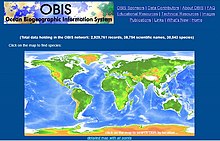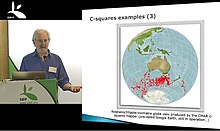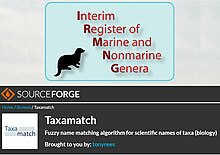Dr Anthony J.J. "Tony" Rees | |
|---|---|
 Tony Rees (centre) with members of the Ocean Biogeographic Information System (OBIS) team pictured at Rutgers University, 2004: Fred Grassle (left), Phoebe Zhang (right) | |
| Born | 1953 (age 70–71) |
| Nationality | British, Australian |
| Known for | Marine biology, Biodiversity informatics, software development |
| Parents |
|
| Awards | Ebbe Nielsen Prize (2014) |
| Scientific career | |
| Fields | Biology, Marine Biology, Biodiversity Informatics |
| Institutions | University College London, CSIRO Division of Fisheries (later CSIRO Marine and Atmospheric Research |
| Thesis | (1979) |
| Doctoral advisor | Gordon F. Leedale |
| Author abbrev. (botany) | A.J.J.Rees |
| Website | fishbase.de/.. |
Anthony J. J. ("Tony") Rees (born 1953) is a British-born software developer, data manager and biologist resident in Australia since 1986, and previously a data manager with CSIRO Marine and Atmospheric Research.[1] He is responsible for developing a number of software systems currently used in science data management, including c-squares, Taxamatch, and IRMNG, the Interim Register of Marine and Nonmarine Genera. He has also been closely involved with the development of other biodiversity informatics initiatives including the Ocean Biogeographic Information System (OBIS), AquaMaps, and the iPlant Taxonomic Name Resolution Service (TNRS).
Biography[edit]
Rees was born in Coventry, UK to an academic family[a] and studied for a degree in Plant Sciences at the University of Leeds from 1971-1974, publishing one paper on the description of a new chrysophyte alga from his undergraduate work.[5] Subsequently he obtained a Ph.D. from the same University, with a thesis entitled "The phytoplankton of a eutrophic lake: community dynamics and ultrastructural studies".[6][b] In the 1980s he worked for the Micropalaeontology Unit of the Geology Department at University College London[7] before migrating to Australia where he managed the electron microscope facility for the CSIRO Division of Fisheries until that facility's closure in 1996, whereupon he transitioned into the area of marine data management for the same science agency. In that position he combined oceanographic and marine biological data management[8] and developed an interest in the emerging field of biodiversity informatics, also including a role assisting the technical development of the Ocean Biogeographic Information System (OBIS) being developed by J. Frederick Grassle in the U.S.A. From 2009-2014 he managed the Australian node of OBIS, located at CSIRO,[9] and also collaborated with other national and international biodiversity informatics and data sharing initiatives including the Encyclopedia of Life, the Global Biodiversity Information Facility, the Atlas of Living Australia, the Open Tree of Life project, FishBase, and others. Rees left CSIRO in 2014, since when his Interim Register of Marine and Nonmarine Genera project has been hosted on data infrastructure at the Flanders Marine Institute (VLIZ) in Belgium, with which he continues an involvement as at 2022.
Development of data management tools[edit]



In 2002 Rees devised a grid-based identification system "c-squares" for units of geographic space to which areas of scientific operation by particular research projects in his agency could be allocated;[10] by designing the system to cover any scale from global to local, c-squares was also a good fit for the initial spatial data handling of both the OBIS and the subsequent AquaMaps projects, in addition to its original implementation within CSIRO Fisheries' "MarLIN" metadata system. A 2006 upgrade of the "c-squares mapper" software to produce rotatable and zoomable "globe views" was an early, browser-based, implementation of a virtual globe,[11] pre-dating the eventual availability of the (far better specified) Google Earth software as a user-addressable web application.
In 2003-2004, Rees was responsible for a redesign of the OBIS search and display software utilising both c-squares for rapid spatial search and mapping of the resulting marine species distribution information, and pre-indexing of all distributed content at a central data hub so that reliance on live, distributed queries to remote, federated data suppliers was removed; this redesign went live in the production version of OBIS in 2004.[12] At the same time, he introduced a "backbone taxonomy" for OBIS data holdings based on the then-latest (2003) edition of the Catalogue of Life, with individual names flagged as either marine or nonmarine, since OBIS wished to expose only the marine element of content supplied by external systems which did not always discriminate between records on the basis of habitat.
Aware of taxonomic gaps in this last effort arising from incompleteness in the then Catalogue of Life, in 2006 Rees commenced a new taxonomic data compilation entitled the "Interim Register of Marine and Nonmarine Genera" (IRMNG) which attempted to list all published genera of the world and assign them either a marine, or nonmarine status (later this simple distinction was further broken down into marine/brackish/freshwater and terrestrial states), also an extant/fossil flag for the use of systems that wished in addition to discriminate between extant and fossil taxa. IRMNG, initially conceived as a short term data compilation project, turned out to be more complex to complete than initially envisaged and continues to the present time under the auspices first of CSIRO in Australia, then (2016 onwards) hosted at the Flanders Marine Institute (Dutch: Vlaams Instituut voor de Zee, VLIZ) in Belgium.[13][14][15]

An additional software tool developed by Rees is a method for spell checking scientific names of organisms entitled "Taxamatch" that aims for high recall (no candidate correctly spelled names missed) and also good precision (rejection of "false hits"), when an input (potentially misspelled) name is supplied and a list of correctly spelled names is available against which it can be tested.[16] This method has subsequently been adopted as a useful feature in a number of global taxonomic databases including the iPlant Taxonomic Name Resolution Service for plants,[17] the World Register of Marine Species (WoRMS) and its dozens of component individual databases,[18] the Euro+Med PlantBase[19] and the EU-NOMEN portal to the Pan-European Species directories Infrastructure (PESI)[20] in addition to its incorporation into IRMNG.
For his work in the area of biodiversity informatics including that on c-squares, OBIS, IRMNG and Taxamatch, the Global Biodiversity Information Facility (GBIF) awarded Rees the 2014 Ebbe Nielsen Prize.[21] Part of the accompanying 2014 citation from GBIF reads:
Ward Appeltans, OBIS manager at UNESCO's Intergovernmental Oceanographic Commission, said he was glad Rees' life work, dedication and perseverance were rewarded by this prestigious prize. "Tony Rees has successfully combined two of his passions, informatics and biology, and with the right intuition and knowledge he has built solutions that have been used by thousands of scientists all over the world."[21]
For a period in the 2010s, Rees was a member of the Global Team of the Catalogue of Life, taking part in discussions regarding that projects's ongoing functionality and evolution. He is currently (2021) a member of the Catalogue of Life Taxonomy Group.[22] He was also a member of the international teams responsible for designing and implementing the biodiversity-related AquaMaps (global predictive maps for aquatic organisms) and iPlant TNRS (Taxonomic Name Resolution Service) projects, described in the scientific literature in 2010 and 2013, respectively.[23][17] Five-degree global "c-squares" cells were also used as the fundamental reporting and analysis units for the first standardized data analysis and mapping of global marine biogeographic realms by M. Costello et al. in 2017.[24] In 2020, data from IRMNG were used to release as a data table, and provide summary statistics on, all of the known genera of the world and their synonyms, as held in IRMNG at that time.[15] Meanwhile, the International Council for the Exploration of the Sea (ICES) have most recently been using c-squares as the underlying spatial grid for managing all of their vessel monitoring systems (VMS) and fishing logbook data, and have also built several applications around this including "FishFrame" (refer C-squares article for more information), and the EU-funded Horizon 2020 ATLAS Project which studied vulnerable marine ecosystems (VMEs) in the North-East Atlantic also adopted c-squares as the underlying spatial grid for its main data structure, the VME Index.[25]
See also[edit]
- C-squares
- Ocean Biogeographic Information System
- Interim Register of Marine and Nonmarine Genera
- CSIRO Marine and Atmospheric Research
Notes[edit]
- ^ Rees' family was academically, but not specifically scientifically inclined; his mother Freda Rees (née Bennett) attended St Hilda's College, Oxford in 1938[2] while his father Henry Rees obtained a Ph.D. in economic geography in 1955 following a first degree at the London School of Economics, lectured in geography, authored a number of textbooks on the subject, and was involved in the early stages of the creation of the University of Warwick.[3][4]
- ^ Gordon F. Leedale, supervisor of Rees' postgraduate studies, was formerly a colleague of the previous professor of Botany at Leeds University Irene Manton, whose electron microscope facility in the basement of "Botany House" was a continuing resource for future students, including Rees and a number of his near-contemporaries.
References[edit]
- ^ ORCID record: Tony Rees
- ^ University of Oxford Gazette, 6 February 2014: Obituaries, p. 302
- ^ VIAF entry: Rees, Henry, 1916-2006
- ^ warwick.ac.uk: Obituary: Henry Rees - 1916 - 2006
- ^ Rees, Anthony J.J.; Leedale, Gordon F.; Cmiech, Helena A. (1974). "Paraphysomonas faveolata sp. nov. (Chrysophyceae), a fourth marine species with meshwork body-scales". British Phycological Journal. 9 (3): 273–283. doi:10.1080/00071617400650331.
- ^ Rees, Anthony John Joseph, 1979. The phytoplankton of a eutrophic lake: community dynamics and ultrastructural studies. Ph. D. Thesis, University of Leeds, 152 pp. Available online via https://etheses.whiterose.ac.uk/153/
- ^ Lord, A.R.; Cooper, M.K.E.; Corbett, P.W.M.; Fuller, N.G.; Rawson, P.R.; Rees, A.J. (1987). "Microbiostratigraphy of the Volgian Stage (Upper Jurassic), Volga River, USSR". Neues Jahrbuch für Geologie und Paläontologie - Monatshefte. 1987 (10): 577–605. doi:10.1127/njgpm/1987/1987/577.
- ^ Finney, Kim & Rees, Tony, 2000. "Metadata and data management activities at CSIRO Marine Research, Australia." in: Hiscock, K. (Ed.) Using marine biological information in the electronic age. Proceedings of the Conference held on 19–21 July 1999. Occasional Publication. Marine Biological Association of the United Kingdom, 7: pp. 35-4. Available at http://www.vliz.be/en/imis?module=ref&refid=338963
- ^ OBIS Australia: About Us (archived version, April 2013)
- ^ Rees, Tony (2003). "'C-squares', a new spatial indexing system and its applicability to the description of oceanographic datasets". Oceanography. 16 (1): 11–19. doi:10.5670/oceanog.2003.52.
- ^ "C-squares Mapper Help". CSIRO Marine & Atmospheric Research. Retrieved 21 September 2021.
- ^ Rees, Tony & Zhang, Phoebe. 2007. "Evolving concepts in the architecture and functionality of OBIS, the Ocean Biogeographic Information System". in Vanden Berghe, E. et al. (ed.) Proceedings of Ocean Biodiversity Informatics: an international conference on marine biodiversity data management Hamburg, Germany, 29 November-1 December 2004. IOC Workshop Report, 202, VLIZ Special Publication 37: pp. 167-176.(PLEN-18-03)]. Publications Office of the European Union, Luxembourg, 95 pp. ISBN 978-92-79-98374-0, doi:10.2760/335280
- ^ Rees, Tony (2008). "18.8. IRMNG—the Interim Register of Marine and Nonmarine Genera" (PDF). The Proceedings of TDWG. 2008: 72–73.
- ^ Rees, Tony; Vandepitte, Leen; Decock, Wim; Vanhoorne, Bart (2017). "IRMNG 2006–2016: 10 years of a global Taxonomic Database". Biodiversity Informatics. 12: 1–44. doi:10.17161/bi.v12i0.6522.
- ^ a b Rees, Tony; Vandepitte, Leen; Vanhoorne, Bart; Decock, Wim (2020). "All genera of the world: an overview and estimates based on the March 2020 release of the Interim Register of Marine and Nonmarine Genera (IRMNG)". Megataxa. 1 (2): 123–140. doi:10.11646/megataxa.1.2.3.
- ^ Rees, Tony (2014). "Taxamatch, an algorithm for near ('fuzzy') matching of scientific names in taxonomic databases". PLOS ONE. 9 (9): e107510. Bibcode:2014PLoSO...9j7510R. doi:10.1371/journal.pone.0107510. PMC 4172526. PMID 25247892.
- ^ a b Boyle, Brad; Hopkins, Nicole; Lu, Zhenyuan; et al. (2013). "The taxonomic name resolution service: an online tool for automated standardization of plant names". BMC Bioinformatics. 14: 16. doi:10.1186/1471-2105-14-16. PMC 3554605. PMID 23324024. S2CID 2731008.
- ^ Vandepitte, Leen; Vanhoorne, Bart; Decock, Wim; et al. (2018). "A decade of the World Register of Marine Species – General insights and experiences from the Data Management Team: Where are we, what have we learned and how can we continue?". PLOS ONE. 13 (4): e0194599. Bibcode:2018PLoSO..1394599V. doi:10.1371/journal.pone.0194599. PMC 5889062. PMID 29624577.
- ^ the Euro+Med PlantBase - the information resource for Euro-Mediterranean plant diversity,
- ^ http://www.eu-nomen.eu: PESI Taxon Match tool. Accessed 15 August 2021.
- ^ a b "CSIRO's Tony Rees named 2014 Ebbe Nielsen Prize winner". GBIF. Retrieved 10 December 2018.
- ^ Catalogue of Life: COL Governance. Accessed 15 August 2021.
- ^ Ready, Jonathan; Kaschner, Kristin; South, Andy B.; et al. (2010). "Predicting the distributions of marine organisms at the global scale". Ecological Modelling. 221 (3): 467–478. doi:10.1016/j.ecolmodel.2009.10.025.
- ^ Costello, Mark J.; Tsai, Peter; Wong, Pui Shan; et al. (2017). "Marine biogeographic realms and species endemicity". Nature Communications. 8 (1): 1057. Bibcode:2017NatCo...8.1057C. doi:10.1038/s41467-017-01121-2. PMC 5648874. PMID 29051522.
- ^ Turner, Phillip J.; Gianni, Matthew; Kenchington, Ellen; Valanko, Sebastian; Johnson, David E. (2021). "New scientific information can help to inform the evaluation of EU deep-sea fisheries regulations". The International Journal of Marine and Coastal Law. 36 (4): 627–646. doi:10.1163/15718085-bja10074. S2CID 240257476.
External links[edit]
- List of Tony Rees' publications on Google Scholar
- Tony Rees research profile at Researchgate
- C-squares home page and project page on SourceForge
- Home page for the Interim Register of Marine and Nonmarine Genera
- Taxamatch resources page at csiro.au, project page on SourceForge, plus a poster explaining the principle and operation of Taxamatch, prepared for the 2009 London e-biosphere conference in Biodiversity Informatics
- Tony Rees 2014 plenary talk "Selected Innovations in Biodiversity Informatics" (invited presentation for 2014 GBIF Ebbe Nielsen Prize): details and official recording on Vimeo